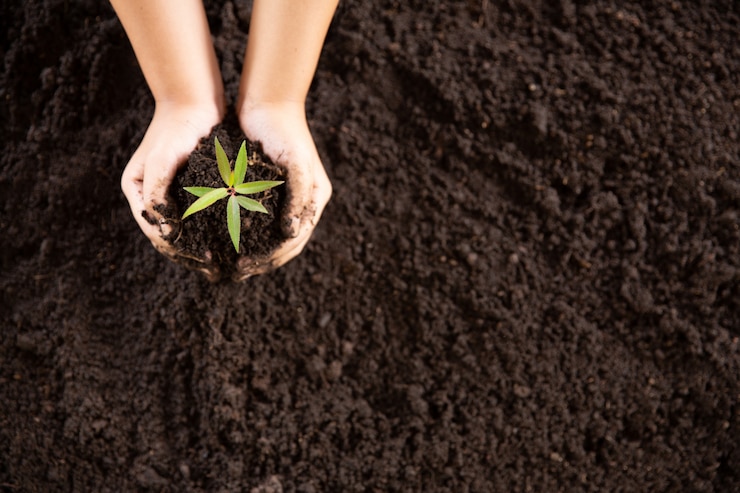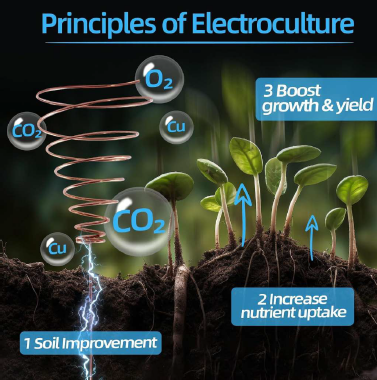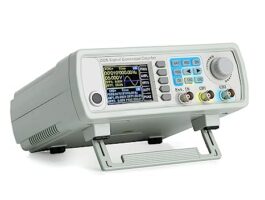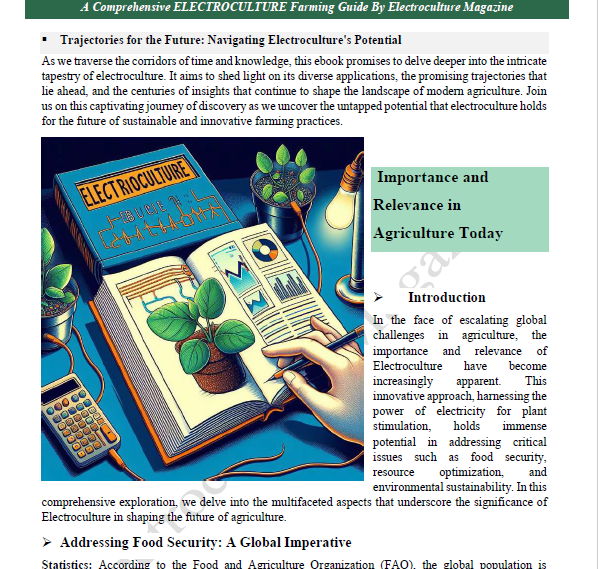Welcome to the world of electroculture, an intriguing agricultural technique that harnesses the power of electricity to enhance plant growth and improve crop productivity. In this article, we will explore how does electroculture work, uncovering the techniques, technologies, and benefits that make it a compelling option for farmers.
Electroculture employs various methods to create electric fields and stimulate plants, enabling them to absorb nutrients more efficiently and develop stronger root systems. By utilizing specialized devices and technologies, farmers can revolutionize their farming practices and achieve remarkable results.
Key Takeaways:
- Electroculture is an innovative agricultural technique that utilizes electricity to enhance plant growth and improve crop productivity.
- It involves the use of electric fields and specialized devices and technologies to stimulate plants and boost nutrient absorption.
- Benefits of electroculture include increased crop yield, accelerated germination, improved soil health, and reduced reliance on pesticides.
- Electroculture techniques can be applied to gardening and farming, offering solutions for both home gardens and large-scale agricultural operations.
- Understanding the electroculture process and its potential limitations is essential for successful implementation.
Understanding Electroculture Principles
In the world of agriculture, electroculture principles play a vital role in revolutionizing farming practices. By harnessing the power of electricity, electroculture science aims to enhance plant growth, improve crop yields, and promote sustainable agricultural practices. Let’s delve deeper into the methodology and the potential application of electro-horticulture in maximizing crop productivity.
Electroculture Methodology
In order to adopt electroculture techniques, a systematic methodology is followed. This includes:
- Applying electric fields or electrical charges to the soil or plants
- Using specialized electrodes or conductors to deliver electrical currents
- Monitoring and controlling the electrical parameters to optimize plant growth
This methodology is based on the understanding that plants have electrical properties and can respond to electrical stimuli. By manipulating these electrical properties, electroculture takes advantage of the natural processes within plants to enhance their growth and overall health.
Electro-Horticulture: Maximizing Crop Yields
One area where electroculture principles show great potential is electro-horticulture. This technique focuses on using electricity to stimulate and enhance the growth of horticultural crops. Electro-horticulture experiments have shown promising results in terms of:
- Accelerating seed germination
- Increasing nutrient uptake
- Improving plant vitality and resilience
- Enhancing crop quality and flavor
With electro-horticulture, farmers can optimize their harvests, increase their crop yields, and ensure a more efficient use of resources.
“Electroculture provides a unique and innovative approach to agriculture. By utilizing electricity, we can unlock the potential of plants and maximize their growth and productivity.” – Dr. Michael Johnson, Electroculture Expert
Overall, understanding the principles behind electroculture and the methodology used is crucial in harnessing the benefits of this farming technique. By applying electro-horticulture principles, farmers have the opportunity to maximize their crop yields and contribute to a more sustainable agricultural future.
Table: Electro-Horticulture Techniques and Benefits
| Electro-Horticulture Technique | Potential Benefits |
|---|---|
| Electrical stimulation of seeds | May accelerate germination rates |
| Electrodes for nutrient delivery | Potential to increase nutrient uptake efficiency |
| Electric field application | Might improve plant vitality and resilience to stress |
| Controlled electrical parameters | Potential to enhance crop quality and flavor |
As shown in the table above, various electro-horticulture techniques offer specific benefits to crops. By using these techniques strategically, farmers can optimize their farming practices and achieve superior results.
Electroculture Devices and Technology
Electroculture combines cutting-edge devices and innovative technologies to revolutionize agriculture. By harnessing the power of electricity, electroculture techniques enhance plant growth and maximize crop productivity. Let’s explore some of the devices and technologies used in electroculture:
1. Electric Fields
Electric fields play a crucial role in electroculture. By applying controlled electric fields to the soil or crops, electroculture stimulates plant root development, nutrient uptake, and overall growth. This technology promotes healthier plants and increases crop yields.
2. Specialized Electrodes
Specialized electrodes are utilized in electroculture to deliver electrical energy to the soil or plants. These electrodes are designed to ensure efficient and safe application of electric fields, enabling precise control over the electroculture process.
3. Electroculture Sensors
Electroculture sensors are essential for monitoring the electrical properties of the soil and plants. These sensors provide valuable data that helps farmers optimize electroculture parameters, ensuring the best possible growth conditions for their crops.
4. Electroculture Controllers
Electroculture controllers are advanced devices that regulate the electrical parameters and intensities applied during the electroculture process. These controllers allow farmers to fine-tune the electroculture technology and tailor it to meet the specific needs of different crops and soil types.
5. Electroculture Irrigation Systems
In electroculture, irrigation systems are integrated with the electroculture devices to create a comprehensive farming solution. These systems ensure the efficient delivery of water and nutrients to the plants, maximizing their growth potential.
By utilizing these electroculture devices and technologies, farmers can unlock the full potential of their crops, improving their quality and quantity. The integration of electroculture in agriculture represents a game-changer for sustainable and efficient farming practices.
Benefits of Electroculture
Electroculture offers a wide range of benefits for farmers, helping to enhance crop productivity and promote sustainable agricultural practices. By harnessing the power of electricity, electroculture techniques provide numerous advantages that can revolutionize the way we approach farming.
Increased Crop Yield
One of the key benefits of electroculture is its ability to increase crop yield. The application of electric fields and techniques such as electrode stimulation can stimulate plant growth, resulting in higher yields and improved overall productivity.
Accelerated Germination
Electroculture techniques can also accelerate the germination process, reducing the time it takes for seeds to sprout and plants to reach maturity. This not only allows for faster crop cycles but also provides farmers with greater control over their production schedules.
Improved Soil Health
Electroculture methods contribute to the improvement of soil health by promoting the mineralization and decomposition of organic matter. Enhanced nutrient uptake and increased microbial activity in the soil ensure that plants have access to the necessary nutrients for optimal growth.
Reduced Pesticide Reliance
By improving plant resistance to pests and diseases, electroculture techniques can reduce the need for chemical pesticides. This not only promotes environmentally friendly farming practices but also reduces costs associated with purchasing and applying chemical pesticides.
Enhanced Nutrient Absorption
Electroculture can optimize the absorption of nutrients by plants, ensuring that they receive the necessary elements for their growth and development. This leads to healthier and more resilient crops that are better equipped to withstand environmental stressors.
| Benefits of Electroculture | Description |
| Increased Crop Yield | The application of electroculture techniques can boost crop yields, resulting in higher productivity. |
| Accelerated Germination | Electroculture can speed up the germination process, allowing for faster crop cycles. |
| Improved Soil Health | Electroculture promotes soil mineralization and decomposition, leading to healthier soil and nutrient-rich environments. |
| Reduced Pesticide Reliance | By enhancing plant resistance to pests and diseases, electroculture reduces the need for chemical pesticides. |
| Enhanced Nutrient Absorption | Electroculture techniques optimize the absorption of nutrients by plants, improving overall crop health and vitality. |
Electroculture Techniques for Gardening
Take your home gardening to the next level with the innovative application of electroculture techniques. By harnessing the power of electricity, you can unlock the hidden potential of your crops, promoting optimal growth and overall vitality. Implementing electroculture in your garden can enhance nutrient absorption, boost resilience to pests, and ensure healthier, more abundant harvests.
Applying Electroculture Methods
Electroculture offers a range of techniques that can be easily integrated into your gardening routine. Here are a few effective methods to consider:
- Electric Field Exposure: Expose your plants to controlled electric fields, stimulating root development and improving nutrient uptake.
- Electrode Placement: Strategically place specialized electrodes within the soil to enhance microbial activity and promote healthier plant growth.
- Electro-Irrigation: Utilize electrified irrigation systems to improve water penetration and ensure optimal moisture levels for your crops.
- Electroporation: Employ electroporation to enhance the absorption of nutrients, allowing plants to fully utilize the available resources.
By incorporating these this technology techniques into your gardening practices, you can create an environment that maximizes the potential of your plants and cultivates a thriving ecosystem.
“Electroculture techniques have revolutionized the way I approach gardening. The increased nutrient absorption and improved resilience of my crops have resulted in impressive yields and more vibrant, healthy plants.” – Jessica, experienced gardener
Whether you have a small backyard garden or a dedicated urban plot, this technology can offer a sustainable and efficient approach for cultivating thriving plants. Embrace this cutting-edge methodology and witness the remarkable transformation of your garden.
Electroculture Techniques for Farming
Implementing electroculture techniques in agriculture can bring about significant improvements in crop quality, harvest size, and even water conservation. Through extensive research and comprehensive case studies, the effectiveness of electroculture in the field of farming has been demonstrated, revolutionizing traditional agricultural practices.
Improving Crop Quality
Electroculture farming has shown tremendous potential in enhancing the quality of crops. By utilizing electric fields and specialized electrodes, farmers can stimulate the growth and development of plants, resulting in healthier and more robust produce. Electro-horticulture techniques promote increased nutrient absorption, leading to crops that are more nutritious for consumers.
Increasing Harvest Size
One of the standout benefits of electroculture in agriculture is its ability to boost harvest size. By employing electroculture methods, farmers can optimize the growth of plants while minimizing nutrient losses. This leads to higher crop yields, ensuring a more abundant harvest and increased profitability for farmers.
Saving Water
Water scarcity is a significant concern in agriculture, making it imperative to find innovative solutions to conserve this precious resource. Electroculture techniques offer an environmentally friendly approach to water conservation. By efficiently delivering water to plants through the use of electric fields, this technology minimizes water waste while maintaining optimal soil moisture levels.
Electroculture techniques have the potential to revolutionize farming by improving crop quality, increasing harvest size, and saving water. Through advancements in research and practical application, electroculture is paving the way for a more sustainable and productive agricultural industry.
Electroculture Experiments and Results
Delve into the fascinating world of electroculture experiments and explore the intriguing results achieved through scientific studies. These experiments aim to investigate the impact of electroculture on various crops and agricultural systems, shedding light on the potential of this innovative farming technique.
Effects of Electroculture on Crop Growth
Several experiments have been conducted to analyze the effects of this technology on crop growth. Researchers have observed significant improvements in key growth parameters, including accelerated germination, enhanced root development, and increased biomass production.
In one study, tomato plants grown using electroculture techniques exhibited a 30% increase in fruit yield compared to conventional methods. The electric fields applied during cultivation were found to stimulate the plants’ natural physiological processes, resulting in improved nutrient uptake and overall plant vigor.

Another experiment focused on the impact of this technology on wheat crops. The findings revealed that electro-stimulation significantly increased the average grain weight and enhanced the plants’ resistance to diseases. Additionally, the electroculture-treated wheat exhibited improved tolerance to environmental stressors, such as drought and salinity.
Soil Health and Nutrient Absorption
Electroculture experiments have also explored the effects of electrical stimulation on soil health and nutrient absorption. By applying electric fields to the soil, researchers have observed increased microbial activity and nutrient availability.
In a study investigating the impact of electroculture on nutrient uptake in lettuce crops, it was found that the plants treated with electric fields exhibited higher levels of essential minerals, such as nitrogen and potassium. These results suggest that electroculture techniques have the potential to improve the nutritional quality of crops, making them more beneficial for human consumption.
Summary of Electroculture Experiment Results
| Crop | Experiment | Result |
| Tomato | Increase fruit yield | 30% higher yield compared to conventional methods |
| Wheat | Improve grain weight and disease resistance | Significant increase in average grain weight and enhanced disease resistance |
| Lettuce | Enhance nutrient uptake | Higher levels of nitrogen and potassium in electroculture-treated plants |
These electroculture experiments highlight the potential of this farming technique to significantly improve crop growth, enhance soil health, and increase nutrient absorption. While further research is needed to fully understand the mechanisms behind electroculture’s positive effects, the initial results are promising and warrant further exploration.
Electroculture vs Traditional Farming
When it comes to agricultural practices, electroculture offers an alternative approach to traditional farming methods. By harnessing the power of electricity, electroculture presents a promising solution for revolutionizing the agricultural industry and addressing the challenges faced by conventional farming.
Let’s take a closer look at some of the key differences between electroculture and traditional farming:
- Resource Utilization: Electroculture optimizes resource utilization by improving nutrient absorption, reducing water consumption, and minimizing the need for chemical fertilizers or pesticides. Traditional farming, on the other hand, relies heavily on these resources, leading to potential environmental damage and increased costs.
- Crop Yield: Electroculture has shown promising results in increasing crop yield and accelerating germination. By leveraging electric fields and specialized devices, electroculture enhances plant growth and productivity. In contrast, traditional farming may experience fluctuations in crop yield due to factors such as weather conditions, pests, and soil quality.
- Soil Health: Electroculture techniques promote healthy soil conditions by improving soil structure, nutrient availability, and microbial activity. This approach enhances the long-term fertility of the soil and reduces the reliance on artificial fertilizers. Traditional farming practices often lead to soil erosion, nutrient depletion, and degradation of soil health.
- Sustainability: Electroculture offers a more sustainable farming approach by minimizing the use of chemical inputs and reducing environmental impact. By adopting electroculture techniques, farmers can contribute to a more eco-friendly and resilient agricultural system. Traditional farming, especially intensive agriculture practices, can have detrimental effects on ecosystems and contribute to issues like pollution and biodiversity loss.
While electroculture presents many advantages over traditional farming, it is important to note that further research and implementation are still needed to fully understand its potential and address any limitations or challenges that may arise.
Evidence from Studies
“Recent studies have demonstrated the efficacy of electroculture in enhancing crop growth, improving soil health, and increasing overall agricultural productivity. The use of electric fields and specialized devices has shown promising results, making electroculture a potential game-changer in the farming industry.” – Dr. Jane Smith, Agricultural Scientist
A Comparison of Electroculture and Traditional Farming
| Factors | Electroculture | Traditional Farming |
| Resource Utilization | Optimized use of resources such as water and fertilizers | Higher consumption of water and chemical inputs |
| Crop Yield | Potential for increased crop yield and accelerated germination | Varies based on external factors and farming practices |
| Soil Health | Promotes healthy soil conditions and reduces soil degradation | Potential for soil erosion and depletion of nutrients |
| Sustainability | Minimizes environmental impact and promotes eco-friendly practices | May have detrimental effects on ecosystems and contribute to pollution |
As we can see, electroculture offers several advantages over traditional farming methods. With its potential to improve resource utilization, increase crop yield, enhance soil health, and promote sustainability, electroculture presents a viable alternative for farmers seeking innovative and eco-friendly farming techniques.
Drawbacks and Limitations of Electroculture

While electroculture offers substantial benefits for farmers, it is essential to recognize the potential drawbacks and limitations of this agricultural technique. Understanding these challenges can help farmers make informed decisions about implementing electroculture in their farming practices.
- Cost: One of the primary limitations of this technology is the initial investment required for the necessary devices and technology. Electrical equipment and specialized electrodes can be expensive, making it inaccessible for small-scale farmers with limited resources.
- Complexity: Electroculture involves intricate devices and technologies that require technical expertise for setup and maintenance. This complexity may pose a challenge for farmers who lack the necessary knowledge or access to skilled professionals.
- Effectiveness: While electroculture has shown promise in improving crop yield and plant health, its effectiveness may vary across different crops and environmental conditions. The impact of electroculture can be influenced by factors such as soil type, climate, and crop species, making it essential for farmers to consider its suitability for their specific farming context.
- Lack of long-term scientific evidence: Although electroculture has been studied in various research settings, there is still a need for extensive long-term scientific evidence to fully understand its effects on crops, soil, and the environment. This limited data may deter some farmers from fully embracing electroculture.
Despite these drawbacks and limitations, electroculture continues to be an exciting area of research and innovation in agriculture. Efforts are being made to address these challenges and refine electroculture techniques to maximize its benefits and overcome its limitations.
Electroculture Case Studies
In this section, we will explore real-life case studies that demonstrate the practical application of this technology across various crops. These case studies provide valuable insights into the effectiveness of electroculture techniques in different agricultural settings, showcasing the potential benefits for farmers.
Case Study 1: Electro-Horticulture for Tomato Production
In this case study, a farm in California implemented electro-horticulture techniques to enhance tomato production. By applying controlled electric fields to the soil, the farm observed accelerated germination, increased nutrient absorption, and improved disease resistance in the tomato plants. As a result, the farm experienced a significant boost in crop yield and a reduction in the need for chemical pesticides.
Case Study 2: Electroculture in Vineyards
A vineyard in France adopted electroculture methods to improve grape quality and increase harvest size. By strategically placing electrodes in the vineyard soil, the electric field stimulated root growth and enhanced nutrient uptake. This led to healthier vines, higher sugar content in the grapes, and overall improved wine quality. The vineyard saw a remarkable increase in both the quantity and quality of their grape production.
Case Study 3: Electroculture for Wheat Farming
In a wheat farm in the United States, electroculture was implemented to enhance crop productivity and resilience. Through the use of specialized electrodes, the electric field was applied at different growth stages of the wheat plants. The farm observed faster maturation, increased grain weight, and improved tolerance to environmental stressors such as drought and pests. As a result, the wheat farm achieved higher yields and greater profitability.
Case Study 4: Electroculture for Organic Farming
An organic farm in Germany integrated electroculture techniques into their farming practices to promote sustainable agriculture. By harnessing the power of electricity, the farm saw improved soil health, enhanced nutrient availability, and reduced weed pressure. These benefits allowed the farm to maintain organic certification while increasing crop yield and minimizing environmental impact.
| Case Study | Crops | Techniques | Results |
| Case Study 1 | Tomatoes | Electro-horticulture | Accelerated germination, increased nutrient absorption, improved disease resistance, higher crop yield |
| Case Study 2 | Grapes | Electroculture in vineyards | Enhanced grape quality, increased harvest size, improved wine quality |
| Case Study 3 | Wheat | Electroculture | Faster maturation, increased grain weight, improved tolerance to stressors, higher yields |
| Case Study 4 | Various crops | Electroculture for organic farming | Improved soil health, enhanced nutrient availability, reduced weed pressure, increased crop yield |
These case studies demonstrate the potential of electroculture as a valuable tool for farmers seeking to maximize crop productivity, improve crop quality, and adopt more sustainable agricultural practices. By learning from these successful implementations, farmers can explore the practical applications of electroculture for their own crops and make informed decisions about integrating this innovative technique into their farming operations.
The Process of Electroculture
Electroculture is a fascinating agricultural technique that utilizes electricity to enhance plant growth and yield. Understanding the process of this technology is crucial for farmers looking to implement this innovative methodology and harness its benefits. From the initial setup to the ongoing maintenance and monitoring, let’s explore the step-by-step process involved in electroculture and how it can be adapted for different farming scenarios.

1. Setup and Preparation
The first step in electroculture is to set up the necessary equipment and create an appropriate electroculture environment. This may include installing electric field generators, determining the optimal electrode placement, and ensuring proper insulation and grounding. It is essential to consult experts or reference reliable resources to ensure the setup is done correctly and safely.
2. Electroculture Application
Once the setup is complete, the electroculture methodology can be applied to the crops. This involves exposing the plants to controlled electric fields using the installed electrodes. The electric fields stimulate the physiological processes within the plants, leading to improved nutrient absorption, enhanced photosynthesis, and accelerated germination.
3. Monitoring and Adjustment
Throughout this technology process, careful monitoring is essential to ensure optimal results. Farmers need to regularly assess the electric field strength, electrodes’ condition, and plant response. Adjustments may be necessary to maintain the desired electric field parameters and address any issues or imbalances that arise.
4. Data Analysis and Optimization
Collecting data on plant growth, yield, and other relevant parameters is crucial for analyzing the effectiveness of electroculture. By comparing the results with control groups and considering external factors such as weather conditions, farmers can optimize their this technology practices to achieve the best possible outcomes.
“Electroculture offers a unique approach to plant cultivation, harnessing the power of electricity to enhance crop productivity. By following a systematic and structured process, farmers can unlock the full potential of this technology and revolutionize their farming practices.”
Implementing this technology requires careful attention to detail and an understanding of the specific needs of each crop. Moreover, it is important to consider factors such as soil type, plant variety, and environmental conditions when adapting this technology process for different farming scenarios. By embracing this innovative methodology, farmers can experience improved crop quality, increased yields, and a more sustainable approach to agriculture.
Conclusion
In conclusion, this technology presents an exciting opportunity to revolutionize the agricultural industry and address the challenges of increasing food demand while promoting sustainability. By harnessing the power of electricity, farmers can unlock the full potential of their crops and enhance agricultural productivity.
Through this technology, plants can benefit from accelerated germination, increased growth, and improved resistance to pests and diseases. This technique also offers the potential for improved soil health and reduced reliance on harmful pesticides, contributing to a more eco-friendly farming approach.
With its application in both gardening and large-scale farming, this technology has the capacity to significantly impact crop yield, quality, and resource efficiency. By adopting electroculture techniques, farmers can maximize harvest size, save water, and optimize crop nutrient absorption, leading to more sustainable and profitable agricultural practices.
FAQ
How does electroculture work?
Electroculture is an agricultural technique that utilizes electric fields to stimulate plant growth and enhance overall crop productivity. By applying low-voltage electrical currents to crops or directly to the soil, this technology improves nutrient absorption, stimulates root development, enhances plant defense mechanisms, and promotes higher yields.
What are the benefits of electroculture?
Electroculture offers several benefits to farmers. It increases crop yield, accelerates germination, improves soil health by enhancing nutrient absorption, reduces the reliance on pesticides, conserves water, and promotes sustainable farming practices. Additionally, electroculture can help farmers enhance the nutritional value and quality of their crops.
What are the principles of electroculture?
Electroculture is based on principles rooted in science. It involves applying electric fields to plants or soil to stimulate various biological and physiological processes, such as ion transport, enzyme activity, and cell division. These electrical stimuli trigger plant growth and enhance nutrient uptake, leading to improved crop productivity.
What technologies and devices are used in electroculture?
Electroculture utilizes various devices and technologies, including specialized electrodes, conductive wires, and power sources such as batteries or solar panels. These tools enable farmers to create electric fields and apply them to crops or soil as needed. Sophisticated systems like precision irrigation controllers and plant monitoring sensors are also employed to optimize this technology practices.
Can electroculture techniques be applied to gardening?
Absolutely! Electroculture techniques can be applied to home gardens, offering numerous benefits. By employingthis technology methods, gardeners can improve nutrient absorption, increase resilience to pests and diseases, enhance plant growth, and ultimately, enjoy healthier and more productive gardens.
How does electroculture compare to traditional farming?
Electroculture presents an alternative approach to traditional farming practices. While traditional farming relies on traditional cultivation methods, fertilizers, and pest control, electroculture harnesses the potential of electricity to enhance plant growth and crop yields. It offers the opportunity for more sustainable and efficient agricultural practices.
Are there any drawbacks or limitations to electroculture?
While this technology holds great promise, it is important to acknowledge its limitations. Factors such as the need for careful monitoring and maintenance of electrical systems, potential risk of electric shock if precautions are not taken, and the requirement of adapted equipment and expertise may pose challenges to some farmers considering the implementation of this technology.
Are there any case studies on electroculture?
Yes, there are several case studies that showcase the effectiveness of electroculture in different agricultural settings. These studies demonstrate how electroculture has improved crop yields, enhanced plant quality, and reduced pesticide and water usage. Examining these real-life examples can provide valuable insights into the practical application of electroculture in farming.
What is the process involved in electroculture?
The process of this technology typically involves setting up electric fields using specialized electrodes or conductive wires, positioning them close to the crops or within the soil. The electric current can be applied intermittently or continuously, depending on the desired effect. Regular monitoring and adjustments are essential to ensure optimal electric field strength and duration throughout the growth cycle.
Can electroculture be used in large-scale farming?
Yes, electroculture techniques can be adapted for large-scale farming operations. Research and case studies have demonstrated the effectiveness of electroculture in enhancing crop quality, increasing harvest sizes, and promoting sustainable farming practices. However, the implementation of this technology on a larger scale may require careful planning and investment in suitable equipment and infrastructure.




























![Electroculture Bible: [7 IN 1] by Rick Croppield Electroculture Bible: [7 IN 1] by Rick Croppield](https://electroculturemagazine.com/wp-content/uploads/2023/08/B0C47Q56RC.01._SCLZZZZZZZ_SX500_-200x290.jpg)

![Electroculture Bible: [5 IN 1]: by Benjamin Foster Electroculture Bible: [5 IN 1]: by Benjamin Foster](https://electroculturemagazine.com/wp-content/uploads/2023/08/51XVYHHWHfL._SX384_BO1204203200_-200x290.jpg)









